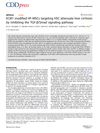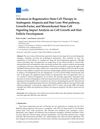TLDR Hair follicle stem cells can help heal intestinal injuries in rats.
The study demonstrated that hair follicle mesenchymal stem cells (HFMSCs) alleviated small intestinal ischaemia-reperfusion (IR) injury in a rat model. HFMSCs were able to home to damaged sites, differentiate into intestinal stem cells, and promote the expression of angiogenic and proliferative markers such as ANG1, VEGF, and IGF1. They also reduced apoptosis by modulating Bcl-2 and Bax expression, decreased oxidative stress, and protected the intestinal mucosal barrier. These findings suggested that HFMSCs could be a promising therapeutic option for treating small intestinal IR injury through both intrinsic and paracrine mechanisms.
8 citations
,
January 2021 in “PubMed” Hair follicle stem cells may help treat acute pancreatitis by reducing inflammation and aiding regeneration.
263 citations
,
February 2020 in “International journal of molecular sciences” ADSCs help in wound healing and skin regeneration but need more research for full understanding.
 64 citations
,
December 2012 in “Stem Cell Reviews and Reports”
64 citations
,
December 2012 in “Stem Cell Reviews and Reports” Human hair follicle cells can be turned into stem cells similar to embryonic stem cells.
 73 citations
,
August 2011 in “Stem Cell Research”
73 citations
,
August 2011 in “Stem Cell Research” Human hair follicle stem cells can turn into multiple cell types but lose some of this ability after being grown in the lab for a long time.
6 citations
,
October 2022 in “Frontiers in Cell and Developmental Biology” Transplanted hair follicle stem cells can heal damaged rat intestines.
4 citations
,
March 2022 in “Pharmaceutics” Regenerative cellular therapies show promise for treating non-scarring hair loss but need more research.
 18 citations
,
February 2022 in “Cell Death Discovery”
18 citations
,
February 2022 in “Cell Death Discovery” ECM1-modified stem cells can effectively treat liver cirrhosis.
22 citations
,
April 2022 in “Stem cell research & therapy” Hair follicle-derived extracellular vesicles may help heal chronic wounds as effectively as those from adipose tissue.
 136 citations
,
May 2019 in “Cells”
136 citations
,
May 2019 in “Cells” Stem cell therapy, particularly using certain types of cells, shows promise for treating hair loss by stimulating hair growth and development, but more extensive trials are needed to confirm these findings.





